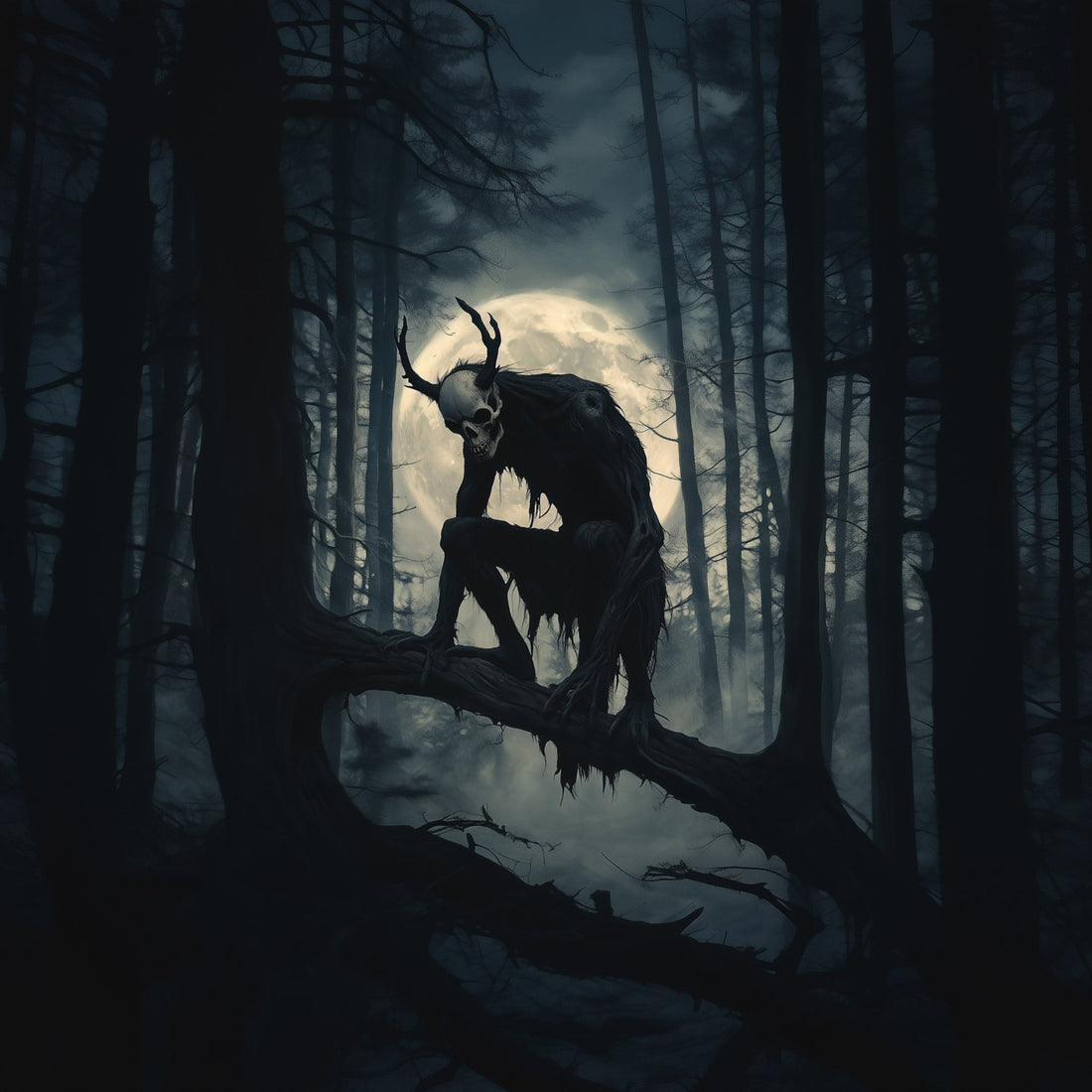
The Haunting Legend of the Wendigo Myth
Share
In the frozen wilderness of North America, a sinister legend has chilled the hearts of storytellers for centuries: the Wendigo. This haunting figure is far more than just a spooky tale—it’s a symbol of greed, hunger, and transformation, deeply rooted in Native American folklore. With its skeletal frame, glowing eyes, and insatiable hunger, the Wendigo is both terrifying and fascinating.
At Urban Myth Apparel, we’ve taken this legendary figure and brought it to life through our bold Wendigo-inspired designs. Join us as we delve into the origins of the Wendigo myth, explore real-life sightings, and uncover why this creature continues to captivate the imagination of so many.
The Origins of the Wendigo Myth
The Wendigo’s roots run deep in the oral traditions of Algonquin-speaking tribes, including the Cree, Ojibwe, and Mi’kmaq. These cultures share variations of the myth, but the core story remains the same: the Wendigo represents the dangers of greed, selfishness, and unchecked hunger.
According to legend, the Wendigo was once human. In times of famine, when survival seemed impossible, individuals driven by desperation resorted to cannibalism. This act of consuming human flesh cursed them, transforming them into Wendigo—gaunt, skeletal creatures doomed to eternal starvation.
Beyond its physical form, the Wendigo serves as a moral cautionary tale. It reminds communities to resist greed and to support one another during hard times, emphasizing collective survival over individual desire.
Physical Description: The Stuff of Nightmares
What does a Wendigo look like? The descriptions vary across tribes, but certain traits are universally agreed upon:
-
Skeletal Frame: The Wendigo is impossibly thin, with protruding bones and sunken skin, symbolizing eternal starvation.
-
Glowing Eyes: Its eyes burn like embers, piercing through the darkest of nights.
- Beastly Features: While often humanoid, the Wendigo sometimes takes on animalistic traits like antlers or claws, enhancing its terrifying presence.
Its supernatural abilities are just as chilling. The Wendigo is said to move with inhuman speed, possess heightened senses, and mimic human voices to lure its victims deeper into the wilderness.
Are Wendigo Real? Myth Meets Reality
The question of whether the Wendigo is real has intrigued believers and skeptics alike. While there’s no physical evidence to support the existence of this creature, its myth is rooted in real psychological and cultural phenomena.
One of the most fascinating aspects of Wendigo lore is Wendigo psychosis—a controversial psychological condition. Documented among Algonquin-speaking communities, Wendigo psychosis describes individuals who develop an insatiable craving for human flesh, even when other food sources are available. While some anthropologists view this as a culturally bound syndrome, others dismiss it as folklore.
Whether the Wendigo is a real creature or a metaphorical warning, its enduring presence in cultural narratives makes it one of the most fascinating legends in North American folklore.
Wendigo Sightings: From Myth to Modern Tales
Over the centuries, there have been numerous accounts of Wendigo sightings, particularly in the remote forests of Canada and the northern United States. While many of these stories can be attributed to misidentifications or exaggerations, they’ve played a significant role in keeping the legend alive.
Historical Sightings
One of the earliest documented Wendigo cases involves Swift Runner, a Cree man in the late 1800s. During a brutal winter, he reportedly murdered and consumed his family, later claiming that the Wendigo spirit had possessed him. This case remains one of the most infamous examples of Wendigo psychosis.
Modern Encounters
In recent years, alleged Wendigo sightings have surfaced on online forums and cryptid enthusiast communities. Witnesses describe a gaunt, skeletal figure with glowing eyes stalking remote areas. While skeptics point to bears or other wildlife as explanations, believers argue that these encounters are proof that the Wendigo is more than just a myth.
The Wendigo in Pop Culture
The Wendigo’s chilling reputation has made it a favorite subject in pop culture, appearing in everything from movies to video games.
-
Film and TV: The Wendigo played a central role in Stephen King’s Pet Sematary, and has appeared in shows like Supernatural and Hannibal, often depicted as a terrifying predator.
-
Video Games: Games like Until Dawn and The Forest incorporate the Wendigo as a central antagonist, blending survival horror with folklore.
- Literature: Writers like Algernon Blackwood have reimagined the Wendigo in chilling short stories, keeping the legend alive for new generations.
This modern fascination highlights the Wendigo’s ability to evolve, adapting to different storytelling mediums while retaining its core essence as a symbol of greed and insatiable hunger.

Urban Myth Apparel’s Wendigo Collection
At Urban Myth Apparel, we celebrate legends like the Wendigo by bringing them to life through bold, eye-catching designs. Our Wendigo T-Shirt features a striking silhouette of this legendary creature, capturing its haunting allure and timeless mystery.
Perfect for fans of folklore and the macabre, this design is more than just apparel—it’s a tribute to one of the most chilling myths in North American history. Pair it with your favorite jacket or hoodie for a look that’s as bold as the story behind it.
Shop the Wendigo Collection: Whether you’re a longtime fan of cryptids or new to the legend, our Wendigo-inspired apparel makes the perfect addition to your wardrobe—or a unique gift for someone who dares to wear the unknown.

The Wendigo is more than just a myth—it’s a timeless story that continues to capture imaginations, from its haunting origins in Native American folklore to its modern-day portrayals in pop culture.
At Urban Myth Apparel, we honor the legends that make us curious and connect us to the unknown. Explore our Wendigo collection today and bring the chilling allure of this legendary creature to your wardrobe.
Which part of the Wendigo myth intrigues you most? Share your thoughts in the comments and shop our designs to keep the legend alive.
